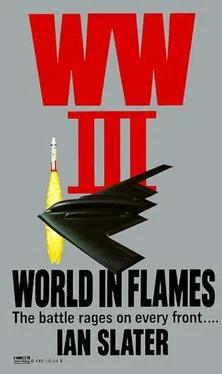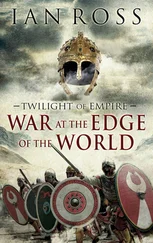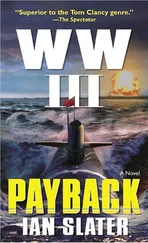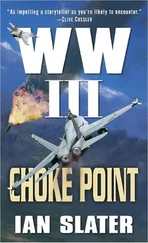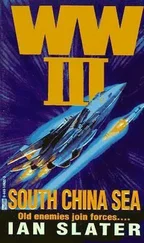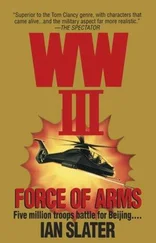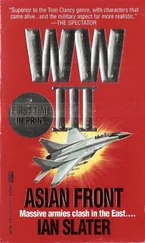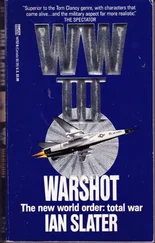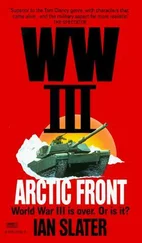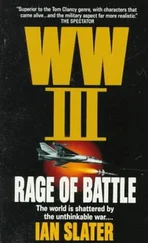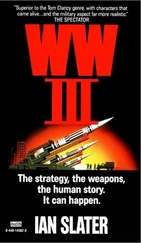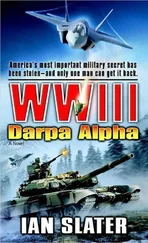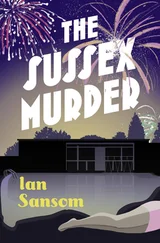“Concert in town?” one of the volunteers asked the SAS regimental sergeant major who turned up to greet them.
“No,” the RSM replied, his quiet Welsh accent surprising to David. “Cymru versus the Barbarians.” Thelman and Brentwood looked at one another in bewilderment.
“Football!” interjected a captain called Cheek-Dawson, wearing the coveted beige SAS beret with the blue-winged dagger above the emblem “Who Dares, Wins.” “Welsh against the English,” he explained. “The singing you hear, needless to say, is coming from the Welsh supporters. If they lose, I daresay we’ll hear a pretty decent requiem.”
“Ah,” said one of the sappers, a Hispanic American, name tag “Bartroli.” “Soccer, right?”
“No, no, man,” said the RSM, his tone good-natured but intent on correction nevertheless. “Not that sissy business. This is rugby.”
“More like American football, right, Sar’Major?” said Cheek-Dawson good-naturedly.
“Without the ruffles,” replied the RSM.
“Ruffles?” challenged Thelman.
“All that padding.”
“Wonder you don’t kill yourselves then,” retorted Thelman.
“It happens,” said the RSM. “All right, lads — into the trucks with kit. Reception at Senny Bridge in—” he glanced at his watch “—half an hour. Fourteen hundred.”
Thelman reminded Brentwood of the joke they’d heard at Parris Island about the first intake of women into the Marine Corps getting it all wrong when the female DI said she’d give them twenty minutes to get ready for kit inspection.
Brentwood fell silent, remembering the last time he’d heard the story was from the British sergeant who’d been murdered along with Lili on the train to Liege.
An Australian listening in to the joke as the trucks pulled away from Brecon station laughed so loud, Thelman thought he’d fall off the tailgate.
“Heard the one about the kangaroo and the priest?” asked the Aussie.
“No,” said Brentwood. The Aussie was talking to them as if he’d known them all his life. He didn’t get to tell them his joke, however, as they were passing the football ground, and a surge of Welsh patriotism, mainly the voices of old men— most of the young ones having been drafted — filled the truck with such emotion that men who’d never heard of rugby were moved.
“You play that in Australia, don’t you?” asked David.
“Yeah, but Australian Rules mainly,” said the Aussie.
“Australian rules?” put in Cheek-Dawson with good cheer. “I should have thought that an oxymoron.”
“What d’ya mean?” said the Aussie. “Moron?”
“Ah — I meant a contradiction in terms,” explained Cheek-Dawson, “You know — Australians and rules? No offense meant.”
The Aussie grinned. “None taken, mate. The name’s Mick. Mick Lewis. They say that with a name like that, I’m half-Irish and half-Welsh. But I can’t sing a bloody note.”
The first hour was like that — informal, the distinction between officer, NCO, and other ranks not paid anywhere like the attention it received elsewhere, particularly in the British forces, where class differences readily became recognizable to even the most recent arrival from overseas. It was different, too, from Parris Island, which surprised David and Thelman, and no doubt many of the other American recruits. No DIs screaming hysterically at you, treating you like dirt even before you got off their bus. And David couldn’t imagine a regular British officer elsewhere joking with the Australian— there certainly wouldn’t have been any apology so readily offered.
Shortly after 1400, they arrived at the SAS HQ at Senny Bridge, eight miles west of Brecon, the headquarters having been moved forty miles west of Hereford on the English side because of Soviet rocket attacks. The Brecon Beacons were covered in deep, fast-moving shadows and then brilliant sunlight. “A dabbledy day,” said the RSM as he jumped down from the jeep leading the three-tonners, and looked up at the jumbled sky. “All right then, lads. Columns of three. Tallest left and right — smallest in the middle. Shake a leg.”
Major Rye, an officer in his midforties with slightly graying hair and a broad, friendly face, dressed in beret, camouflage-pattern battle dress smock and trousers, came out to welcome them. They were all volunteers from every branch of the services — their reasons for volunteering as varied as the men themselves, some bored with life in the line regiments, which, because of the slowdown in supplies occasioned by convoy losses, were now forced to dig in and wait. Others no doubt were escaping domestic entanglements of one kind or other, and some had volunteered because they, as young men, some of them children at the time, had been electrified, as was the whole world, by the riveting spectacle of the first SAS public appearance. There had been rumors that an elite force, called the Special Air Service, had existed, but the first time the world knew the rumors were right was on May 6, 1980, in London in “Operation Nimrod.” The SAS counterterrorist team, covered head to toe in what was to become their telltale black uniform, wearing CS gas masks, which also protected their identity, attacked and, with astonishing speed, ended, in front of the world’s TV cameras, a six-day, twenty-one-hostage drama in the Iranian Embassy. The attack, combining sheer-cliff mountaineering abseiling, stun grenades, and perfect HK MPS submachine-gun kill shots at close range in crowded rooms, was so fast, the Iranian terrorists literally didn’t know what hit them.
Though this constituted the first public view of the SAS, the Special Air Service had already been operating for over thirty years, ever since being formed from an “odd-bod” collection of commando enthusiasts who wreaked such havoc behind the enemy line in the Western Desert, destroying over 380 of Rommel’s German aircraft and vast quantities of oil and ammunition, that Adolf Hitler issued a personal order to the Wermacht regarding the SAS that “these men are dangerous. They must be hunted down and destroyed at all costs.”
After the Second World War, the SAS had carried on its covert service of British foreign policy, involving them in everything from the Malayan Communist emergency to joining the West German counterterrorist CSG-9 in the hostage-rescue attack against the hijacked Lufthansa airliner on the airstrip at Mogadishu in Somalia. The fierce gun battle there lasted for more than seven minutes, but the success of the operation— only one hostage was wounded, and not fatally — was due once again to the extraordinary speed and accuracy of the assault, during which every terrorist aboard was hit in the first bursts of the commandos’ gunfire. And then there were the audacious and devastating night raids in the Falklands War, and later deep inside Iraq, against Saddam Hussein’s airfields.
Over the Sea of Japan, Shirer nosed the 747 down toward the thick cumulonimbus at fifteen thousand, seeking protection of zero visibility against the three breakaway fighters, the 747’s over-the-horizon radar showing the Bogeys were now only sixty miles away, active radars on and coming in arrowhead formation for interdiction at a thousand miles per hour — almost certainly MiG-29 Fulcrums.
Shirer knew the F-14 Tomcats that would try to protect his 747 were good — on afterburner, over a hundred miles an hour faster than the Fulcrums — but, as an ace, he also knew the old rule still held: With the gizmology being more or less equal, over sixty percent of all kills in dogfights went to only the top six percent of pilots.
As the 747 entered the cloud in the pitch darkness, the three Fulcrums now only forty miles away, Shirer called through to the COMCO — countermeasures control officer. “Compute distance from Vladivostok to here and back. Approx.”
Читать дальше
